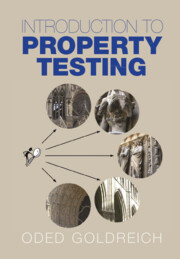Book contents
- Frontmatter
- Contents
- Preface
- Organization and Chapter Summaries
- Notation
- Acknowledgments
- 1 The Main Themes: Approximate Decision and Sublinear Complexity
- 2 Testing Linearity (Group Homomorphism)
- 3 Low-Degree Tests
- 4 Testing Monotonicity
- 5 Testing Dictatorships, Juntas, and Monomials
- 6 Testing by Implicit Sampling
- 7 Lower Bounds Techniques
- 8 Testing Graph Properties in the Dense Graph Model
- 9 Testing Graph Properties in the Bounded-Degree Graph Model
- 10 Testing Graph Properties in the General Graph Model
- 11 Testing Properties of Distributions
- 12 Ramifications and Related Topics
- 13 Locally Testable Codes and Proofs
- Appendix A Probabilistic Preliminaries
- Appendix B A Mini-Compendium of General Results
- Appendix C An Index of Specific Results
- References
- Index
Organization and Chapter Summaries
Published online by Cambridge University Press: 13 November 2017
- Frontmatter
- Contents
- Preface
- Organization and Chapter Summaries
- Notation
- Acknowledgments
- 1 The Main Themes: Approximate Decision and Sublinear Complexity
- 2 Testing Linearity (Group Homomorphism)
- 3 Low-Degree Tests
- 4 Testing Monotonicity
- 5 Testing Dictatorships, Juntas, and Monomials
- 6 Testing by Implicit Sampling
- 7 Lower Bounds Techniques
- 8 Testing Graph Properties in the Dense Graph Model
- 9 Testing Graph Properties in the Bounded-Degree Graph Model
- 10 Testing Graph Properties in the General Graph Model
- 11 Testing Properties of Distributions
- 12 Ramifications and Related Topics
- 13 Locally Testable Codes and Proofs
- Appendix A Probabilistic Preliminaries
- Appendix B A Mini-Compendium of General Results
- Appendix C An Index of Specific Results
- References
- Index
Summary
All chapters rely on a few core notions that are introduced in Sections 1.3.1 and 1.3.3. Although these parts of Section 1.3 provide a sufficient basis for reading any of the subsequent chapters, we strongly recommend reading the entire first chapter before proceeding to any other one.
In contrast to the central role of Chapter 1, no other chapter is essential for reading the other chapters. In particular, interdependencies between the other chapters are rare and never heavily relied on. The main dependencies are depicted in Figure 1, where thematic dependencies are marked by solid lines and technical dependencies by dashed lines.
Although the ordering of the chapters that follow Chapter 1 is not very important, a choice had to be made. We chose to start with simple properties of functions such as group homomorphism, low-degree polynomials, monotonicity (with respect to various partial orders), and depending on few variables (i.e., juntas). In all these cases, the correspondence between the object and its representation is transparent: the function is the object. In contrast, when moving to graph properties, the question of representation arises in an acute manner, and three different chapters are devoted to three different representations that correspond to three different testing models. Hence, from the perspective of property testing per se, it seems to make sense to start with functions and then move to graphs.
In accordance with the foregoing, the first cluster of chapters (Chapters 2–6) deals with testing properties of functions, whereas a second cluster (Chapters 8–10) deals with testing properties of graphs. A chapter on lower bound techniques (i.e., Chapter 7) is located in between these two clusters, since lower bounds are hardly mentioned in the first cluster, whereas they appear quite prominently in Chapters 9 and 10. The reason for this phenomenon is that these lower bounds are used to justify the significantly higher complexity of some testers that are presented in Chapters 9 and 10. Indeed, in the context of this book, we view lower bounds mainly as a justification for algorithms that may be considered to have a higher than expected complexity; the lower bounds assert that this impression is actually false, and that one cannot do significantly better.
Information
- Type
- Chapter
- Information
- Introduction to Property Testing , pp. xv - xxiiPublisher: Cambridge University PressPrint publication year: 2017
